Golden Gotou Part 4 of 6
In the lee of Cape Ose we can relax again and admire the majestic scenery. Now free of the erratic wind waves, the water heaves slowly with a swell from some storm far to the south. These are perhaps our favorite conditions: along the rocky coast, the sea heaving like the chest of a sleeping giant, and although the waves still meet the shore with some force, their rhythm is slow and much more predictable. With some sense of timing, one can slide quickly between rocks propelled by the rising of a swell, or be lifted several meters up near a vertical wall without much danger of being dashed against it.
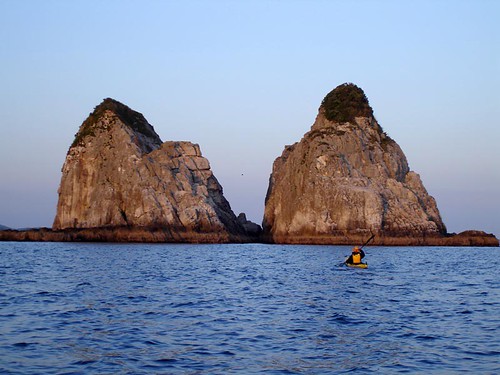
The sun hangs low in the sky and the coast has turned northward away from us in a wide, sweeping bay. We decide to cut short and aim toward Futago-Se, literally and aptly, the Twin Rocks, which the designer of this grand landscape placed just halfway across the bay’s mouth as if to relieve the boredom of sea-traversing kayakers. Each rock towers over 50m high, and the passage between them, although deep, is less than 2m across. The rocks provide a minute or two of entertainment; then it’s on to open water again.
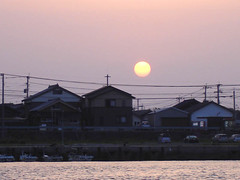
It is dark by the time we arrive at the fishing port of Kurose. Deceived by tourist brochures promising a beach with facilities and perhaps blinded by visions of salty potato chips and other town conveniences, we pass by a beautiful, remote beach, land just outside the dumpy town, and settle on the flat concrete of the port. A walk around the town’s very dark street turned up only a jidouhanbaiki. We drink cans of hot coffee, then pass a restless night as various cars pull in and out of the port and voices are heard fulfilling some questionable purpose. Funny about these ports; some are dead quiet at night, while others seem to be hangouts for shady characters. We were relieved when our GPS announced dawn was around the corner and it was time to get up. Once in the water, we feel again in our element. The sun rises, Japanese style, over the dense wires and cheap-looking plastic houses. This could be Hokkaido, Okinawa, or any place in the 3000km in between.
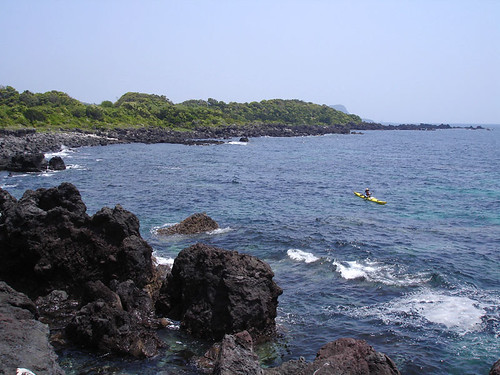
The coast is again low, volcanic, and shelving in great shoals into the sea. The swell has grown overnight, and the shelves become surf zones many times more dangerous than the cliffs we passed yesterday. We give them wide berth but a few still surprise us on the seaward side. These shoals lay like traps, some just deep enough to trip only one wave in 100; this can give the paddler a nasty surprise.
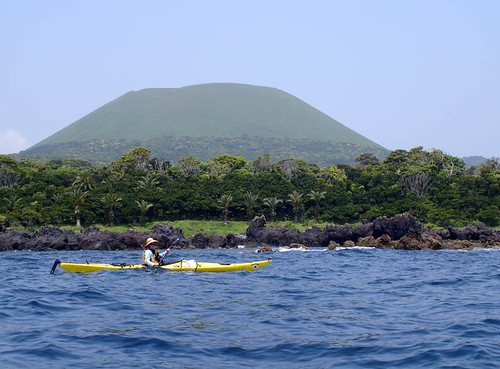
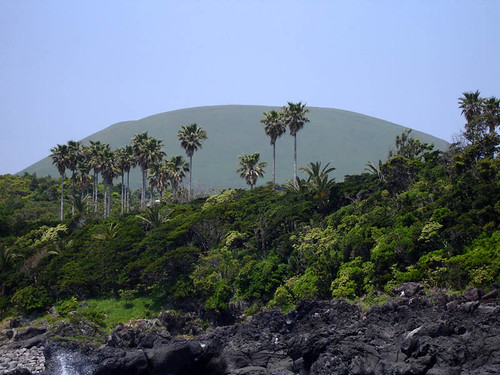
The long-extinct volcano of Onidake dominates the scene. It has been given a buzz-cut and is pushed aggressively as perhaps Gotou’s number one tourist destination. Its grassy dome looks almost artificial in the brown haze that hangs above the sea today.
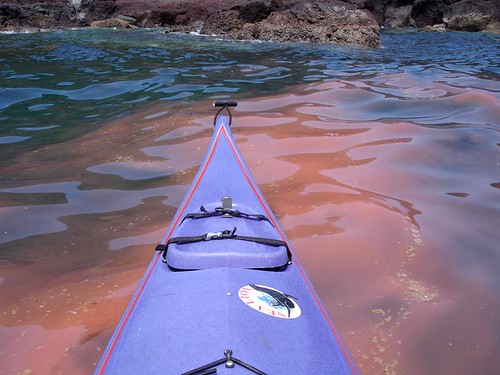
The calm conditions and intense sunshine of the past couple of days has proved too much for the sea, and it breaks out in great splotches of red tide. A winter of absorbing untreated runoff from town and farm has increased nutrient levels, and as soon as the water warms to near 20C, algae growth goes unchecked. We’re somewhat surprised to see so much of this here, where the waves and currents of the open sea regularly wash the coasts. It would not surprise us if absolutely no facilities exist on these islands to clean waste water and farming runoff. When, the next day, we hear a tour guide explaining to the naïve tourists that the red water is actually fish eggs, we have to laugh, wondering if they made this up or are actually told to say so. In any case Leanne takes it upon herself to educate the tourists, for better or worse, what it is they are actually looking at.

The sun hangs low in the sky and the coast has turned northward away from us in a wide, sweeping bay. We decide to cut short and aim toward Futago-Se, literally and aptly, the Twin Rocks, which the designer of this grand landscape placed just halfway across the bay’s mouth as if to relieve the boredom of sea-traversing kayakers. Each rock towers over 50m high, and the passage between them, although deep, is less than 2m across. The rocks provide a minute or two of entertainment; then it’s on to open water again.

It is dark by the time we arrive at the fishing port of Kurose. Deceived by tourist brochures promising a beach with facilities and perhaps blinded by visions of salty potato chips and other town conveniences, we pass by a beautiful, remote beach, land just outside the dumpy town, and settle on the flat concrete of the port. A walk around the town’s very dark street turned up only a jidouhanbaiki. We drink cans of hot coffee, then pass a restless night as various cars pull in and out of the port and voices are heard fulfilling some questionable purpose. Funny about these ports; some are dead quiet at night, while others seem to be hangouts for shady characters. We were relieved when our GPS announced dawn was around the corner and it was time to get up. Once in the water, we feel again in our element. The sun rises, Japanese style, over the dense wires and cheap-looking plastic houses. This could be Hokkaido, Okinawa, or any place in the 3000km in between.

The coast is again low, volcanic, and shelving in great shoals into the sea. The swell has grown overnight, and the shelves become surf zones many times more dangerous than the cliffs we passed yesterday. We give them wide berth but a few still surprise us on the seaward side. These shoals lay like traps, some just deep enough to trip only one wave in 100; this can give the paddler a nasty surprise.


The long-extinct volcano of Onidake dominates the scene. It has been given a buzz-cut and is pushed aggressively as perhaps Gotou’s number one tourist destination. Its grassy dome looks almost artificial in the brown haze that hangs above the sea today.

The calm conditions and intense sunshine of the past couple of days has proved too much for the sea, and it breaks out in great splotches of red tide. A winter of absorbing untreated runoff from town and farm has increased nutrient levels, and as soon as the water warms to near 20C, algae growth goes unchecked. We’re somewhat surprised to see so much of this here, where the waves and currents of the open sea regularly wash the coasts. It would not surprise us if absolutely no facilities exist on these islands to clean waste water and farming runoff. When, the next day, we hear a tour guide explaining to the naïve tourists that the red water is actually fish eggs, we have to laugh, wondering if they made this up or are actually told to say so. In any case Leanne takes it upon herself to educate the tourists, for better or worse, what it is they are actually looking at.


0 Comments:
Post a Comment
<< Home